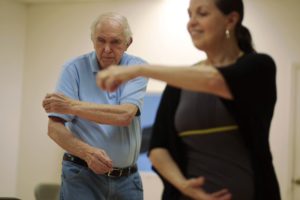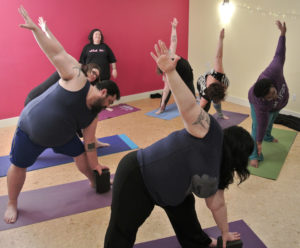Improve Parkinson’s Disease with Group Tai Chi Practice
By John M. de Castro, Ph.D.
“Tai chi, an ancient martial art characterized by slow, flowing movement and meditation, helps improve balance and movement control for people with Parkinson’s disease.” – Tara Parker-Pope
Parkinson’s Disease (PD) is an incurable progressive degenerative disease of the central nervous system. The condition is caused by the death of nerve cells in the brain that produce the neurotransmitter dopamine. There are around seven million people worldwide and one million people in the U.S. living with PD and about 60,000 people are diagnosed with PD every year. PD is associated with aging as the vast majority of patients are diagnosed after age 50. In fact, it has been speculated that everyone would eventually develop PD if they lived long enough.
Its physical symptoms include resting tremor, slow movements, muscle rigidity, problems with posture and balance, loss of automatic movements, and slurring of speech. PD itself is not fatal but is often associated with related complications which can reduce life expectancy, such as falls, choking, and cardiovascular problems. Parkinson’s Disease (PD) also has psychological effects, especially cognitive decline, anxiety, and depression. All of these symptoms result in a marked reduction in the quality of life.
There are no cures for Parkinson’s Disease or even treatments to slow its progression. There are only treatments that can produce symptomatic relief. So, there is a need to discover new and different treatments. Mindfulness training has been found to improve the psychological symptoms and the quality of life with PD patients. Tai Chi and Qigong are ancient mindfulness practices involving slow prescribed movements. They are gentle and completely safe, can be used with the elderly and sickly, is inexpensive to administer, can be performed in groups or alone, at home or in a facility or even public park, and can be quickly learned. In addition, it can also be practiced in social groups without professional supervision. This can make it fun, improving the likelihood of long-term engagement in the practice. In addition, Qigong has been shown to improve the symptoms of Parkinson’s Disease. Hence, Tai Chi and Qigong may be an excellent treatment for the symptoms of Parkinson’s Disease.
The parameters of Tai Chi and Qigong practice that maximize its benefits for the relief of the symptoms of Parkinson’s Disease have not been explored. In today’s Research News article “The Effects of Group-Based versus Individual-Based Tai Chi Training on Nonmotor Symptoms in Patients with Mild to Moderate Parkinson’s Disease: A Randomized Controlled Pilot Trial.” See summary below or view the full text of the study at: https://www.ncbi.nlm.nih.gov/pmc/articles/PMC5546134/, Yang and colleagues investigate the relative effectiveness of Tai Chi practiced alone or in group contexts. They recruited patients with Parkinson’s Disease and randomly assigned them to practice Tai Chi for 45 minutes, 3 times per week, for 13 weeks either alone or in a group of 6 to 7 participants. Home practice was also prescribed. They were measured before and after training for cognitive ability, depression, and the non-motor symptoms of Parkinson’s Disease including cardiovascular, sleep/fatigue, mood/cognition, perceptual problems, attention/memory, gastrointestinal, urinary, and sexual function.
They found that after training both groups showed significant improvement in the overall non-motor symptoms of Parkinson’s Disease and particularly in sleep. Only the group Tai Chi practice participants, however, showed a significant improvement in cognitive (thinking) performance. In addition, the group Tai Chi practice participants had significantly greater compliance with home practice. Hence, Tai Chi regardless of whether practiced in groups of individually improved the non-motor symptoms of Parkinson’s Disease, but practicing it in groups appears to produce an additional improvement in the ability of the patients to process information (Cognition) and improve their likelihood of practicing at home.
The present results, as prior research, make it clear that Tai Chi practice is helpful in relieving the symptoms of Parkinson’s Disease. But, the results also make it clear that practicing in a group may be superior to practicing alone. Group Tai Chi practice may be more fun and engaging, potentiating its effectiveness. Its effectiveness for cognition is particularly important as cognitive decline is a common symptom of the progression of Parkinson’s Disease and complicates the patient’s ability to carry on normal life functions.
So, improve Parkinson’s Disease with group Tai Chi practice.
“Falls are common in people with Parkinson’s, and they can cause serious injuries, including fractures and concussions. Studies show falls are the main cause of hospitalizations in Parkinson’s patients. People in the tai chi group reported half the number of falls compared to those who were taking resistance training and two-thirds fewer falls than people who were doing light stretching exercises.” – Brenda Goodman
CMCS – Center for Mindfulness and Contemplative Studies
This and other Contemplative Studies posts are also available on Google+ https://plus.google.com/106784388191201299496/posts and on Twitter @MindfulResearch
Study Summary
Yang, J. H., Wang, Y. Q., Ye, S. Q., Cheng, Y. G., Chen, Y., & Feng, X. Z. (2017). The Effects of Group-Based versus Individual-Based Tai Chi Training on Nonmotor Symptoms in Patients with Mild to Moderate Parkinson’s Disease: A Randomized Controlled Pilot Trial. Parkinson’s Disease, 2017, 8562867. http://doi.org/10.1155/2017/8562867
Abstract
Objective
To compare the effects of group-based and individual-based Tai Chi training on nonmotor symptoms in patients with mild to moderate Parkinson’s disease.
Design
Randomized controlled pilot study.
Methods
36 community-dwelling patients with Parkinson’s disease (PD) were randomly assigned to either group-based training group (n = 19) or individual-based group (n = 17). Both groups received same content of Tai Chi training 3 times a week for 13 weeks. Participants were also asked to perform home exercises daily. The Non-Motor Symptoms Scale was used to assess global nonmotor symptoms change. Sleep quality, depression, and cognition were evaluated by Parkinson’s Disease Sleep Scale, Hamilton Depression Scale, and Beijing version-Montreal Cognitive Assessment, respectively. Home exercise compliance was recorded.
Results
There was no significant difference between two groups at baseline. After 13 weeks, there were no statistical significance between two groups. However, the within-group effect was different. Participants in group-based and individual-based groups showed a significant improvement on global nonmotor symptoms (P < 0.001, P = 0.004) and sleep (P < 0.001, P < 0.001). But only group-based training patients presented a significant improvement in cognitive impairment compared with baseline (P = 0.002, P − 0.116). For depression, no group gained a significant improvement(P = 0.123, P = 0.170). Group-based participants had a higher home-exercise compliance rate (HeCR) than individual-based participants did (P = 0.019), and HeCR showed a moderate correlation with MoCA-BJ and NMSS scores changes in this study.
Conclusion
Group-based Tai Chi training is considered to be a more effective and a more labor-saving method in the clinical settings, and patients tend to have a higher compliance rate in their home exercise program









